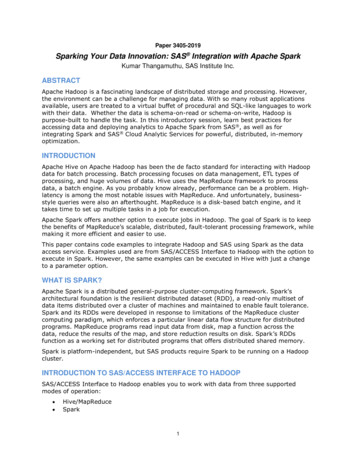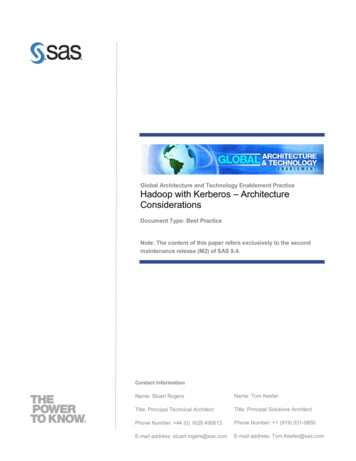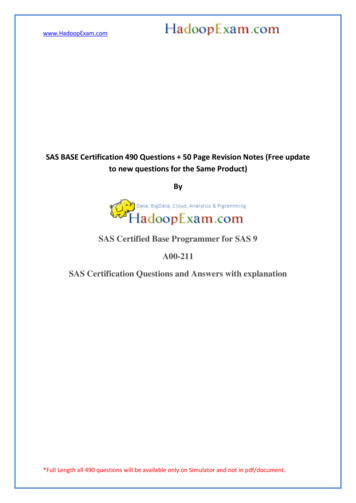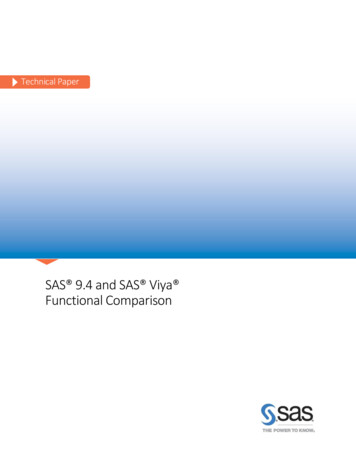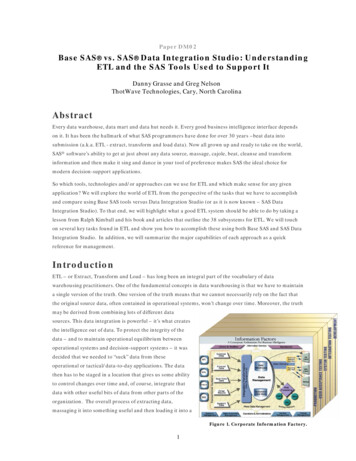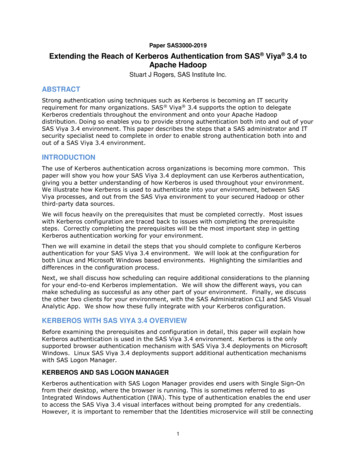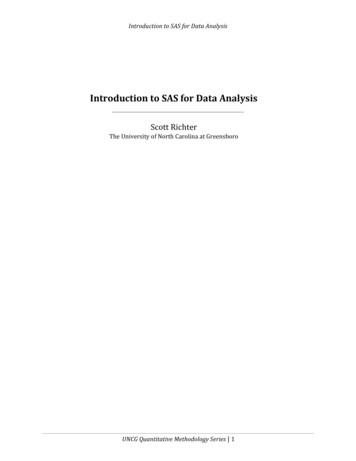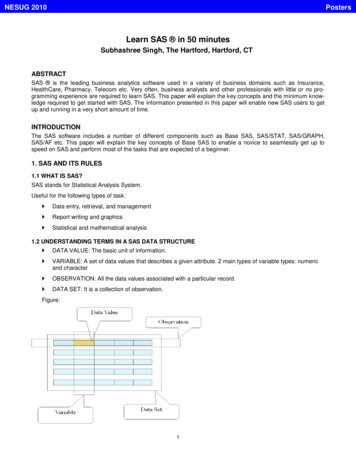
Transcription
NESUG 2010PostersLearn SAS in 50 minutesSubhashree Singh, The Hartford, Hartford, CTABSTRACTSAS is the leading business analytics software used in a variety of business domains such as Insurance,HealthCare, Pharmacy, Telecom etc. Very often, business analysts and other professionals with little or no programming experience are required to learn SAS. This paper will explain the key concepts and the minimum knowledge required to get started with SAS. The information presented in this paper will enable new SAS users to getup and running in a very short amount of time.INTRODUCTIONThe SAS software includes a number of different components such as Base SAS, SAS/STAT, SAS/GRAPH,SAS/AF etc. This paper will explain the key concepts of Base SAS to enable a novice to seamlessly get up tospeed on SAS and perform most of the tasks that are expected of a beginner.1. SAS AND ITS RULES1.1 WHAT IS SAS?SAS stands for Statistical Analysis System.Useful for the following types of task: Data entry, retrieval, and management Report writing and graphics Statistical and mathematical analysis1.2 UNDERSTANDING TERMS IN A SAS DATA STRUCTURE DATA VALUE: The basic unit of information. VARIABLE: A set of data values that describes a given attribute. 2 main types of variable types: numericand character OBSERVATION: All the data values associated with a particular record. DATA SET: It is a collection of observation.Figure:1
NESUG 2010Posters1.3 RULES FOR SAS NAMES SAS variable/variable names must be between 1 and 32 characters long. The first character must be a letter or an underscore. Characters after the first may be letters, digits or underscores.Example: NAME, NAME , FILE1, NULL etc.1.4 RULES FOR SAS STATEMENTS SAS statements may begin in any column of the line. SAS statements end with a semicolon (;). Some SAS statements consist of more than one line of commands. A SAS statement may continue over more than one line.One or more blanks should be placed between items in SAS statements. If the items are special characters suchas ' ', ' ', ' ', the blanks are not necessary.2
NESUG 2010PostersThere are two major building blocks in SAS. DATA step SAS built in procedures2. DATA STEPUsed for: Names the SAS data set and creates the dataset.In a Data step the following can be performed. defining the variables read input files assign values to the variables, creating new variables, merging two data sets formatting and labeling variables assignment of missing values.If a variable is used in a SAS program but not initialized then SAS automatically assign a missing value to it.Numeric missing values are represented by a single period (.). Character missing values are represented by a single blank enclosed in quotes (' ').Syntax:DATA SOMENAME ;The name should be 1-32 characters and must begin with a letter or underscore.Example: DATA EMPDAT;The following SAS statements can be used in a DATA step.2.1 INFILE AND INPUT STATEMENTUsed for: INFILE is used to read external files (such as mainframe file, text files, comma delimited files etc).INPUT is used to define names and order of variables for the SAS dataset.Syntax:INFILE file-specification options ;INPUT variable variable type column(s);Example1:DATA EMPFL;INFILE 'c:\emp\external\emp1.dat';INPUT@001 EMPNO CHAR6.@007 NAME CHAR15.@022 AGE3.;RUN;In this example external file “emp1.data” stored in the location “c:\emp\external” will be read and copied into SASfile EMPFL. Three variables EMPNO, NAME and AGE will be read.3
NESUG 2010Posters2.2 SET STATEMENTUsed for: Reads an existing SAS dataset or concatenating SAS datasetsSyntax:SET SAS dataset name OBS n ;Where “n” is the number of observations you want to read from the file.Example1:Copies first 100 records of OLDFILE1 to NEWFILE.DATA NEWFILE;SET OLDFILE1 (OBS 100);RUN;Example2:Concatenate two datasets.Input SAS dataset:SAS data set NWESTSAS data set SWESTOBS STATE POPOBS STATE POP1WA 3.41NM1.12OR 2.12AZ1.8DATA COMMON;SET NWEST SWEST;RUN;Output SAS data setSAS data set COMMONOBS STATE POP1WA 3.42OR 2.13NM 1.14AZ 1.82.3 IF/THEN; ELSE; STATEMENTUsed for: Used for conditional checking. Used in a data step.Syntax:IF expression THEN statement; ELSE statement; 4
NESUG 2010PostersExample:IF LANG 'Spanish' or LANG 'French' THENNEWLANG 'NotEngl';ELSENEWLANG 'English';Example 2:IF status ‘M' AND type 1 THENcount count 1;2.4 SUBSETTING “IF” STATEMENTUsed for: To subset, or take a portion of the data setSyntax:IF var name somevalue1;IF var name somevalue2 THEN DELETE;Example:DATA FORGNER;IF LANG ‘ENGLISH’;IF TAX 20000 THEN DELETE;RUN;In the above example it will select all observations where LANG equals ‘ENGLISH’ and where TAX greater than orequal to 20000.Notice that values for character variables must be enclosed in quotes and values must match exactly includingcase.2.5 LIBNAME STATEMENTUsed for: Associates a libref with a SAS library. It’s kind of location pointer.This is generally used we want to save the SAS dataset in a permanent location. When a libref is not associatedwith SAS dataset, SAS assumes it is created or read from SAS work area which is temporary in nature.Syntax:LIBNAME libref engine '('SAS-data-library-1' ,.'SAS-data-library-n' ) ';Example:In windows –LIBNAME EMPLIB1 ‘C:\data\SAS\EMPDATA’;The path ‘C:\data\SAS\EMPDATA’ will be assigned to libref EMPLIB1. Say there is a SAS dataset EMPDAT in thatlibrary, it can be access as,DATA EMPFILE1;SET EMPLIB1.EMPDAT;RUN;In Unix –LIBNAME CLAIM ‘\data\CL\CLAIM\INPUT’;DATA CLAIM.LOSS HISTORY;SET LOSS TEMP;RUN;In this example the temporary file LOSS TEMP will be stored in a permanent location ‘\data\CL\CLAIM\INPUT’with a new name LOSS HISTORY.5
NESUG 2010Posters2.6 MERGE STATEMENTUsed for: Joins corresponding observations from two or more SAS data sets. Two types one to one, match merging.Syntax:DATA new-sasdataset;MERGE sasdsname1 sasdsname2 . sasdsnamen;BY var1 var2 varm;RUN;Input data sets must be sorted by the same BY variables before you can merge them. Usually merge statementfollowed by sort procedure.Example:Merge the two files SURVY with NAMES by the variable NAME.DATA NEW;MERGE NAMESSURVY;BY NAME;RUN;SAS data set NAMESSAS data set SURVYOBS NAMEGENDEROBS 27353732SAS data set NEWOBS 545668NAMEJENNIFERMANUELPAULRENEERENEETONY
NESUG 2010Posters3. SAS BUILT IN PROCEDURESSAS provides large number of procedures which is invoked in a "PROC step" which starts with the keywordPROC. Some important SAS built in procedures are described in this section.3.1 PROC CONTENTSUsed for: Lists structure of a SAS dataset. It is very useful when you receive an existing SAS file from someoneand you need to start working on it. Before you start you may want to see the structure of this file.Syntax:PROC CONTENTS DATA SAS dataset name options ;RUN;Example:To list the structure of the SAS dataset EMPFL.PROC CONTENTS DATA EMPFL;RUN;The following is the sample result. SAS also prints other metadata information such as FORMAT, INFORMAT,LABEL, no. of observations, SORT info, INDEX info etc which were not shown here. Please refer to online documentation for details.Alphabetic List of Variables and en86153.2 PROC PRINTUsed for: Lists data as a table of observations.Large datasets are very hard to visualize, so it is useful when you want to print couple of observations for somevariables.Syntax:PROC PRINT options ;VAR variable(s) options ;RUN;Example:To print variables NAME, AGE and GENDER of SAS dataset FILE1.PROC PRINT DATA FILE1;VAR NAME AGE GENDER;RUN;Output will look like:OBS123NAMEKEVINJANEMARYAGE151217GENDERMFF7
NESUG 2010Posters3.3 PROC DELETEUsed for: Delete one or more SAS dataset. It is good programming practice to delete unwanted SAS datasets toincrease SAS work space.Syntax:PROC DELETE DATA Data set name(s) ;RUN;Example:PROC DELETE DATA OLDDATA1 CLAIM.OLDDATE2;RUN;The above statement temporary SAS datasets OLDDATE1 and permanent SAS dataset CLAIM.OLDDATA2 willbe deleted.3.4 PROC SORTUsed for: To rearrange the observations in SAS datasets according to one or more variables.Syntax:PROC SORT NODUP/NODUPKEY DATA SAS-file name OUT SAS-filename ;BY descending variable-1 descending variable-n;RUN;You can sort in ascending or descending order. Default is ascending. BY variables can be numeric or character.Example:PROC SORT DATA ORIG OUT SORTORIG;BY GENDER DESCENDING AGE;RUN;Sorts file first in ascending order of GENDER and within those categories, 1 (Male) and 2 (Female), the cases arefurther sorted in descending order of AGE.PROC SORT is used most often for sorting a data set so that other SAS procedures can process that data set insubsets using BY statements. Data sets must also be sorted before they can be merged or updated.3.5 PROC FREQUsed for: The FREQ procedure produces one way to n-way frequency tables and creates distribution reports ofthe variable values. This procedure used for categorical data.Syntax:PROC FREQ option ;BY variables;OUTPUT OUT SAS-data-set options ;TABLES requests / options ;RUN;Example:Find out unique values of the variable department in SAS dataset ‘EmpFile’.PROC FREQ DATA EmpFile;TABLES Department /OUT Freq Department;RUN;The FREQ FinanceResearch66437.5037.5025.00Cumulative CumulativeFrequency Percent637.501275.00816100.00
NESUG 2010Posters3.6 PROC MEANSUsed for: The MEANS procedure summarizes data. It computes descriptive statistics for variables within groupsof observations or across all observations. This procedure generally used for continuous data.Syntax:PROC MEANS option(s) statistic-keyword(s) ;BY variable-1 . variable-n ;CLASS variable(s) / option(s) ;OUTPUT OUT SAS-data-set output-statistic ;RUN;Example:Find out no. of employees, average, maximum, minimum, sum of salary for ‘EmpFile’ by department.PROC MEANS DATA EmpFile N MEAN MAX MIN SUM;VAR salary;BY department;OUTPUT OUT SumEmpFile;RUN;Remember to sort the file by variable ‘department ‘ before using the variable in ‘BY’ statement of proc mean asgiven below.PROC SORT DATA EmpFile;BY department;RUN;9
NESUG 2010Posters4. SOME IMPORTANT SAS FUNCTIONSThis section is for advance reading.For user’s benefit some important SAS functions are mentioned below which can be used in a data step.4.1. DATE (): produces the current date as SAS date, value representing the number of days between January1, 1960 and the current date.E.g., Today Date DATE();The value of Today Date will be 18499 which means August 25, 2010.Then a SAS data format can be used to read the date. Refer to PUT function for details.4.2. DAY (DATE): It returns an Integer representing the day of the month from SAS DATE value.E.g. Day1 DAY(Today Date);The value of Day1 will be 25.4.3. MONTH (DATE): It returns the numeric value representing the month from SAS DATE value.E.g. Month1 MONTH(Today Date);The value of Month1 will be 8.4.4. YEAR (DATE): It returns the 4 digits numeric value representing the year from SAS DATE value.E.g. Year1 YEAR(Today Date);The value of Year1 will be 2010.4.5. LENGTH(argument): Calculate length of a variable or a constant. Default length of numeric variable is 8.E.g. String2 'Rocky Hill';Len1 LENGTH(String2);The value of Len1 will be 10 which is the length of the string ‘Rocky Hill’.4.6. SUM(variable-1, variable-2, .,variable-n): Calculates sum of non-missing arguments.E.g. Num1 5;Num2 2.5;Sum1 SUM(Num1,Num2);The value of Sum1 will be 7.54.7. MIN(variable-1, variable-2, .,variable-n): Returns the value of the lowest of its non-missing arguments.E.g. Min1 MIN(9,0,-2,45);The value of Min1 will be -24.8. MAX(variable-1, variable-2, .,variable-n): Returns the value of the lowest of its non-missing arguments.E.g. Max1 MAX(9,0,-2,45);The value of Max1 will be 454.9. INT(argument): This function taken one numeric argument and returns integer portion of the argument.E.g. Int1 INT(332.502);The value of Int1 will be 3324.10. CEIL(argument): The CEIL function returns the smallest integer that is greater than or equal to the argument.E.g. Ceil1 CEIL(9.231);Ceil2 CEIL(-9.231);The value of Ceil1 will be 10 and Ceil2 will be -9.4.11. FLOOR(argument): The FLOOR function takes one numeric argument and returns the largest integerthat is less than or equal to the argument.E.g. Floor1 FLOOR(9.231);Floor2 FLOOR(-9.231);The value of Floor1 will be 9 and Floor2 will be -10.10
NESUG 2010Posters4.12. PUT (source,format) : Write the value of source with a specified format. PUT function is used to convertnumeric value to a character value and also to format numeric and date variables into various formats.E.g. Date Formatted PUT(Today Date,DDMMYY10.);Here DDMMYY10. is the DATE format. Please refer to SAS online documentation to get a list of variousformats.The value of Date Formatted will be 25/08/2010.4.13. UPCASE(argument): Converts all letters in an argument to uppercase.E.g. String2 'Rocky Hill';Upcase1 UPCASE(String2);The value of Upcase1 will be ‘ROCKY HILL’.4.14. LOWCASE(argument): Converts all letters in an argument to uppercase.E.g. String2 'Rocky Hill';Lowcase1 LOWCASE(String2);The value of Lowcase1 will be ‘rocky hill’.4.15. CATS(variable-1, variable-2, .,variable-n) and : It removes leading and trailing blanks, and concatenates the arguments. (two pipe signs) also can be use to concatenate multiple strings. Unlike CATS function does not remove leading and trailing blanks.E.g. Var1 "United ";Var2 " States";Con1 CATS(Var1,Var2,"of America");Con2 'Var1 Var2 "of America"';The value of Con1 will be ‘UnitedStatesof America’ where as value of Con2 will be ‘United StatesofAmerica’.4.16. TRANWRD(source, target, replacement): TRANWRD replaces or removes all occurrences of a word ina string.E.g. OldText ’This is OLD’;OldWord ’OLD’;NewWord ’NEW’;NewText TRANWRD(OldText,OldWord,NewWord);The value of NewText will be ‘This is NEW’.4.17. SUBSTR (argument, position , n ) : It returns the portion of the string specified in the argument fromthe position up to the number of characters specified by n.E.g. String1 'THE HARTFORD';SubString1 SUBSTR(String1,5,4);The value of SubString1 will be ‘HART’.4.18. TRIM (argument): It copies a character argument removing any trailing elements.E.g. String3 'SAS Institute';Trim1 trim(String3);The value of Trim1 will be 'SAS Institute’.11
NESUG 2010PostersCONCLUSIONSThis paper is submitted to help out new SAS users to accustom them to SAS in less on/onlinedoc/91pdf/index.htmlACKNOWLEDGMENTSThanks to the SAS online support for prompt responses to my questions.Many thanks to Adil Khan for reviewing my paper and encourage me to write this paper.SAS and all other SAS Institute Inc. product or service names are registered trademarks or trademarks of SASInstitute Inc. in the USA and other countries. indicates USA registration.Other brand and product names are registered trademarks or trademarks of their respective companies.CONTACT INFORMATIONYour comments and questions are valued and encouraged. Contact the author at:Subhashree SinghThe HartfordOne Hartford PlazaHartford, CT 06155Work Phone: 860-547-2398Email: Subhashree.Singh@thehartford.com, Subhashree ************12
SAS/AF etc. This paper will explain the key concepts of Base SAS to enable a novice to seamlessly get up to speed on SAS and perform most of the tasks that are expected of a beginner. 1. SAS AND ITS RULES 1.1 WHAT IS SAS? SAS stands for Statistical Analysis System. Useful for the follo

